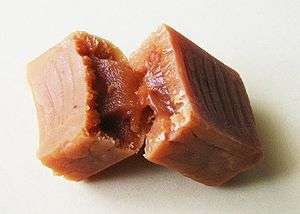Krówki
Krówki ([ˈkrufki], plural; krówka singular), literally meaning "little cows," are Polish fudge, semi-soft milk toffee candies. When hand-made, they are hard and crispy on the outside, but the inside is more "fluid" than solid.
 | |
| Type | Fudge |
|---|---|
| Place of origin | Poland |
| Main ingredients | Milk, sugar, cream, butter, vanilla |
It is one of the most common Polish confections, sold worldwide, and might be considered "dulce de leche candy". Commercially, many brands are available; most of them have each individual candy wrapped in white-and-yellow paper with a picture of a Holstein cow. Widely known across Europe even before the end of the Cold War, they are something of an equivalent of the White Rabbit Creamy Candy famous across East Asia, or Scottish Tablet.
The original recipe usually contains milk, sugar, and sometimes butter, cream and vanilla flavor.[1] There are also fruit (e.g. banana),[2] cocoa,[2] coffee, nut,[2] liquorice[2] flavored krówki available, as well as versions made from soy milk for lactose intolerant consumers. Krówki can be prepared at home, using a simple cast iron pan and the above-mentioned ingredients.
The confectionery company "L. Pomorski i syn" claims that the first krówki were produced in Poznań by the Pomorski family, which was later expelled by Nazi Germans to Milanówek near Warsaw during World War II.[3]
In Germany, krówki are often called Muh-Muhs[4] (after the sound cows make) or Kuhbonbons (cow bonbons).[5]
List of Traditional Polish Products
Krówki added to the list of Polish Traditional Products by Minister of Agriculture:
- "Krówka Opatowska" - is being made since 1982, handmade cut, packed and produced in traditional way in Opatów. Added to the list of Traditional Products list in 07.02.2011
- "Krówka Szczecinecka" - is produced since 1971, in Szczecinek, added to the Traditional Products list in 19.01.2016
See also
- Cajeta
- Caramel
- Confiture de lait
- Flan
- Dulce de Leche
- List of Polish desserts
- Maillard reaction
- Penuche
- Prince Polo
- Teja

References
- Krówki and other Polish confectionery - description
- ZPC Milanówek - Krówka (in Polish) [retrieved 22 December 2015]
- L. Pomorski Archived March 17, 2012, at the Wayback Machine
- PICO Food GmbH
- Savitor GmbH